- By Dan Veaner
- Around Town
 Print
Print 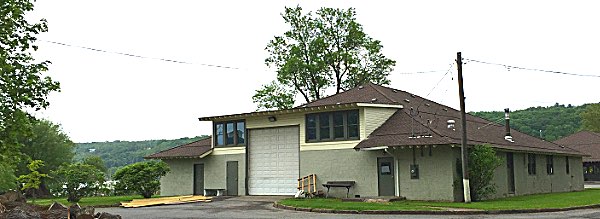
Last October a restored Thomas Morse S4 Scout ('Tommy'), that had been originally built in Ithaca 100 years prior, flew over the Tompkins Airport with more than 2,500 people watching. In May the Tompkins County Center for History & Culture officially opened on the Ithaca Commons. If all goes well the next local history milestone will be the Wharton Studio Museum on the Stewart Park lakefront, in a building where major motion pictures were made from 1913 to 1919.
"We want to do the construction in 2021 The goal is to have a big part of the revitalization done by 2021 because that's the park's centennial year," Wharton Studio Museum Executive Director/Co-Founder Diana Riesman. "We have good support from the City, the County and the State. I am an optimistic person and also very tenacious, so we hope to make it happen."
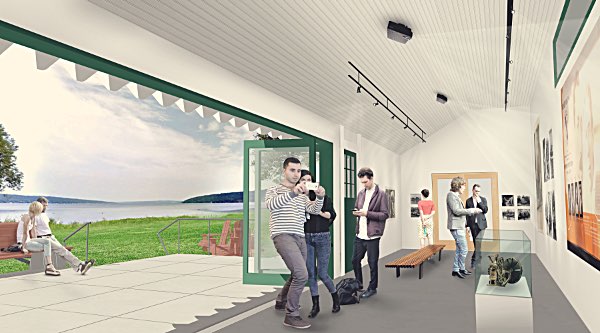 A rendering of the Wharton Studio Museum (Photo Courtesy of the Wharton Studio Museum)
A rendering of the Wharton Studio Museum (Photo Courtesy of the Wharton Studio Museum)The museum will be a 1,000 square foot gallery space in the original Wharton Studio building, with a patio facing Cayuga Lake, a meeting room available to rent for events, and a small shop. The project is expected to cost $1.1 million. The outside of the gallery will be screened by bushes to separate it from the larger portion being used by the Ithaca Department of Public Works (DPW, and a mural is planned for the large retractable door used to enter the old studio that opens into the film stage. The actual film stage space is used to store DPW equipment and materials.
"The whole building, but more importantly the whole area of the park - we call this the historic pavilion complex - this whole area which encompasses the picnic pavilion, the plaza (currently a parking lot in between the buildings) and the Wharton building would become kind of the cultural recreational hub of the park," Riesman says.
The studio building is the middle stop in the newly established Finger Lakes Film Trail that was created in April. It includes three stops: includes the George Eastman Museum in Rochester, the Wharton Studio Museum in Ithaca, and the Case Research Laboratory in Auburn where Theodore Case was one of the first people to sync sound to motion pictures.
"So you have this lovely narrative of early American film making, from early film stock to the silent movie to the talkies," Riesman says.
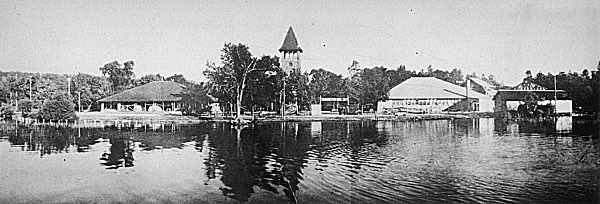 Wharton Studio around 1915 (Photo Courtesy of the Wharton Studio Museum)
Wharton Studio around 1915 (Photo Courtesy of the Wharton Studio Museum)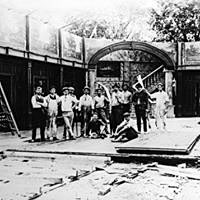 An outdoor set is erected in Renwick Park (Photo Courtesy of the Wharton Studio Museum)Theodore Wharton knew Ithaca because his wife had relatives in Ludlowville. He and his brother Leo established the Wharton Studio in Renwick Park, now Stewart Park, and made major motion pictures between 1914 and 1919, with major stars including Pearl White, Irene Castle, Oliver Hardy, Creighton Hale, King Baggot, Marguerite Snow, Lionel Barrymore, as well as many local actors, foremost among them Bessie Wharton, Leo's wife. The Whartons used over 45 acres of the park for their studio, including the stage building, pavilions, and a tower that reportedly had an office in it before it was destroyed in 1954 by Hurricane Hazel. In addition to the indoor stage, outdoor stages were set up as needed.
An outdoor set is erected in Renwick Park (Photo Courtesy of the Wharton Studio Museum)Theodore Wharton knew Ithaca because his wife had relatives in Ludlowville. He and his brother Leo established the Wharton Studio in Renwick Park, now Stewart Park, and made major motion pictures between 1914 and 1919, with major stars including Pearl White, Irene Castle, Oliver Hardy, Creighton Hale, King Baggot, Marguerite Snow, Lionel Barrymore, as well as many local actors, foremost among them Bessie Wharton, Leo's wife. The Whartons used over 45 acres of the park for their studio, including the stage building, pavilions, and a tower that reportedly had an office in it before it was destroyed in 1954 by Hurricane Hazel. In addition to the indoor stage, outdoor stages were set up as needed.Location shooting was at various local landmarks, including Fall creek, Ludlowville Falls, and Ithaca Falls, as well as downtown Ithaca.
"What drew Theodore Wharton here was the natural beauty of the gorges and the lake," Riesman says. "I think the Whartons saw all the potential in all these beautiful backdrops for exciting scenes for their dramas and mysteries. I think a similar thing that attracts people to Ithaca today is this nice, melding of the rustic and the urban. They had their studio here. There could be in the forest, and then if they needed an urban shot they could just drive to town and have that urban setting."
She says that the whole area of the park - called the historic pavilion complex - encompassing the picnic pavilion, the plaza (currently a parking lot in between the buildings) and the Wharton building will become the cultural recreational hub of Stewart Park.
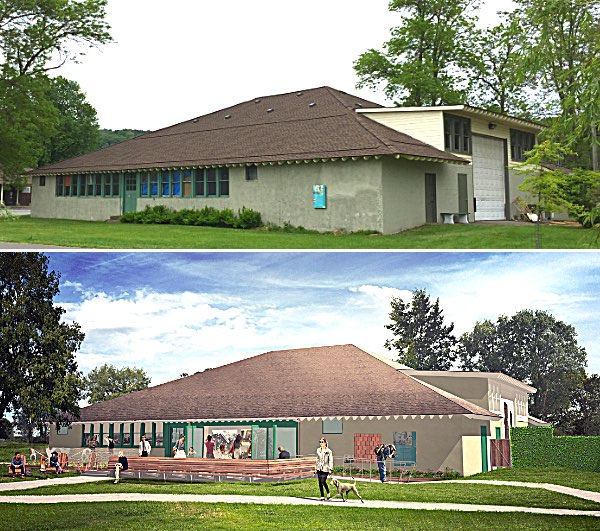 The Wharton Studio Museum, before and after. ('After' rendering Courtesy of the Wharton Studio Museum)
The Wharton Studio Museum, before and after. ('After' rendering Courtesy of the Wharton Studio Museum)Originally called 'Ithaca Motion Picture Project' the organization was established as a 501 (c) (3) nonprofit in 2009. NYC Education Department’s Board of Regents granted a Provisional Museum Charter in 2013 under its new name, Wharton Studio Museum. The charter was renewed last year. This year the museum became a founding partner in the new Tompkins Center for History and Culture, where it has a permanent display and a small office upstairs. It functions like a museum even though it doesn't yet have its own space. It has created exhibits around Ithaca, and holds a variety of events including the 'Silent Movie Under the Stars' program at Taughannock Falls, October 'Movie Month' and 'Silents Roar', a student film festival held each April. The Museum offers a self-guided tour that begins with the studio building, visits sites in Ithaca and the Cornell campus, the Stewart Avenue Bridge that was used in 'Prince of India', and goes as far as Robert Treman State Park, an important location in the gold rush drama, 'The Great White Trail'.
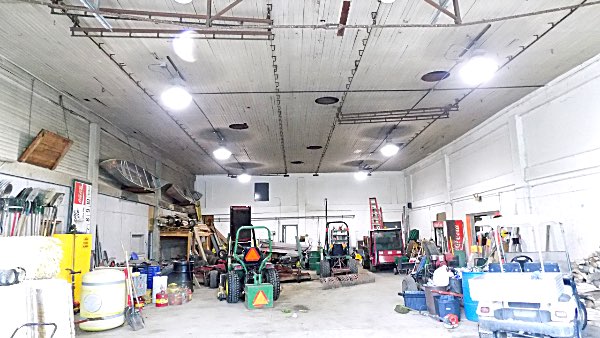 The film stage is used by the City of Ithaca Department of Public Works. Original tracks that were used for hanging scenery hang from the ceiling, that has holes cut into it that may have been used for lighting.
The film stage is used by the City of Ithaca Department of Public Works. Original tracks that were used for hanging scenery hang from the ceiling, that has holes cut into it that may have been used for lighting."Only a handful of motion picture studios from that era are still standing," she says. "We're lucky to have it in our in our main city park, by the lake and now along the Waterfront trail. Really significant movie history happened here in this building. The Whartons made hundreds and hundreds of films starring some of the best known actors of the day. This building is one of only a handful of early motion picture studios still standing in the country. So it's a very cool remnant artifact from that era."
Building a museum, like everything else, costs money. Hoping for state support for the project, Riesman invited NYS Senator Tom O'Mara to view the building in 2015.
"We stood in the Wharton building and talked about our plans for the park and the waterfront and the building. He just kind of 'got it' right away. He came back in the spring of 2017. We talked more and I showed him the proposal. I sent the final draft to him in early 2018, and he liked it."
O'Mara exceeded her expectations last August when his office called to tell her he had secured a $450,000 grant for the project. That covers just under half the funds needed to complete the museum. Working closely with Friends of Stewart Park, she says a local campaign will be launched to raise the remaining funds needed, and that campaign may extend beyond Tompkins County's borders, because films made here were shown in theaters across the United States and around the world.
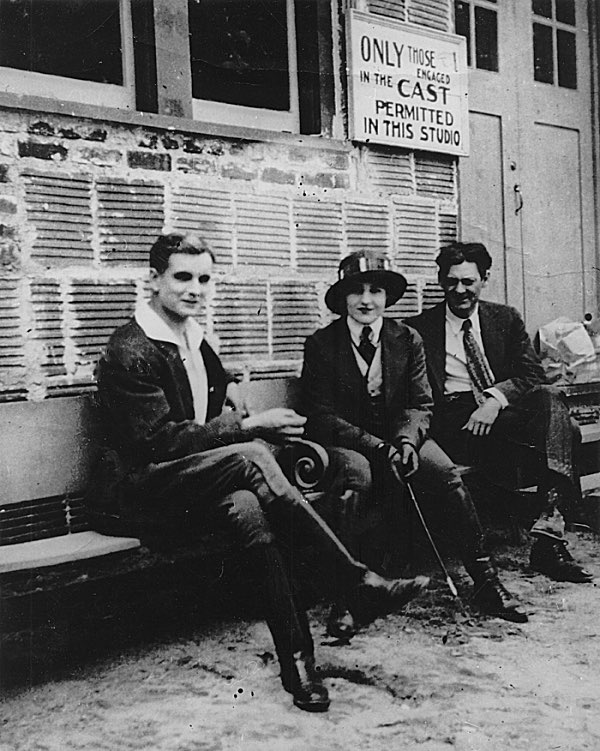 Wharton Studio Museum Executive Director Diana Riesman says she plans to recreate the sign that said 'Only those engaged in the cast permitted in this studio' in its original location, and place a bench where famous movie actors waited to be called to film scenes in silent movies. Pictured, from left: Creighton Hale, Pearl White, Lionel Barrymore (Photo courtesy of Wharton Studio Museum)
Wharton Studio Museum Executive Director Diana Riesman says she plans to recreate the sign that said 'Only those engaged in the cast permitted in this studio' in its original location, and place a bench where famous movie actors waited to be called to film scenes in silent movies. Pictured, from left: Creighton Hale, Pearl White, Lionel Barrymore (Photo courtesy of Wharton Studio Museum)Riesman says that preserving the studio building will give visitors a vivid flavor of what it was like in the pioneer days of film making. She says the Whartons embraced Ithaca while they made films here, hiring Ithacans as cinematographers, costume designers, actors, extras, and crew members. She notes that a few of those like cinematographer Ray June went on to Hollywood, (June was nominated for an Academy Award for his work on 'Funny Face'). With the completion of the museum -- which Reisman hopes will coincide with the 2021 hundredth birthday of Stewart Park -- Ithacans will again be able to embrace the Whartons and the rich film history that made Ithaca a major motion picture center before Hollywood.
"When I stand in the building -- and I'm not someone who is into spirits and ghosts -- but when I walk in I go 'what must this have been like? You're making movies here 100 years ago, and in the winter. It must have been pretty challenging and incredible. They were very entrepreneurial, and they were making it up as they went along. It was all new."
v15i21



